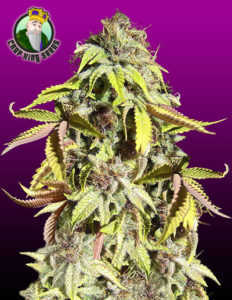Crown Royale
Crown Royale is pretty much everything a great strain of weed could possibly be. It’s attractive to look at and easy to grow, has a great taste and offers significant medical benefits.
Bred by Crop King Seeds, Crown Royale is a cross between Blueberry and Purple Kush. It has landrace strains further back in its pedigree, including Hindu Kush, which is a benefit to growers since it helps to make Crown Royale more robust.
The marijuana strain Crown Royale tastes absolutely nothing like the drink with a similar name. It is packed full of fruitiness with berries and pineapple for sweetness and citrus to bring a refreshing tang. This is counterbalanced by spiciness and a dank underbelly. The aroma is actually very fresh, with clear notes of citrus and pine.
With 17% to 21% THC, Crown Royale can certainly produce a buzzy, energetic head high, however it’s known as a strain which takes a bit of time to get going, possibly because of the Indica genetics. This means that instead of blasting off the way you would expect from a Sativa, what generally happens is that you start to feel a reduction in pain and improvement in mood and then, one step at a time, the effect builds up until the pain is gone and in its place you have sparkling good humour. The transition down into the Indica full-body stone is equally gentle. The relaxation, however, is so complete that this strain is generally best kept for use in the evening. Aside from its obvious benefits to anyone suffering from insomnia, Crown Royale has become known as an excellent headache strain, even providing relief for migraines. In fact it’s effective for pretty much any kind of pain and/or emotional disorders such as anxiety and depression.
In principle, Crown Royale can be grown indoors or outdoors, but outdoor growers will need to be confident that their local climate will support daytime temperatures of around 21C. Additionally, if growers want to bring out purple/blue tones in the leaves, they will need to ensure that the plants are exposed to cold (not freezing) temperatures towards the end of the vegetative stage. This, however, is purely cosmetic and so entirely optional. Although Crown Royale is a hybrid, it grows to be short and broad in typical Indica style and while this makes plant training unnecessary, growers should be prepared to “top” their plants by trimming away any leaves which are blocking the light from lower nodes. This will encourage buds to develop further down the plant. Crown Royale will finish flowering in about 9 weeks indoors and harvest around late September outdoors. Yields are very respectable with 500g/m2 being perfectly feasible indoors. The key point to remember with Crown Royale is always to buy your seeds from a reputable supplier. The fact that, at this time, Crown Royale is relatively hard to find, both in seed form and as weed, means that some growers may be tempted to take a punt on seeds from sources they would usually avoid. This is usually a mistake as comments on forums demonstrate.
Strain Characteristics: | |
Indoors or outdoors (in warmer climates) | Short |
Medium/high | Nine weeks |
Balanced hybrid (physically resembles an Indica.) | End September |
Blueberry and Purple Kush | High |
Easy/Medium |




I know you pasted this info above from Wikileaf, but the author doesn’t know what “topping” is. They indicate you should top the plant by removing fan leaves. Topping – as EVERY person who has ever grown a plant knows – is pinching off the top of a branch above the node to encourage two new branches to grow. It’s a simple training technique to keep plants short and bushy with an even canopy of flowering sites, ideal for indoor growing where light penetration is poor. What the author describes is defoliation or defanning. It is most often performed at the end of the vegetative cycle, and again around F21 and F43.